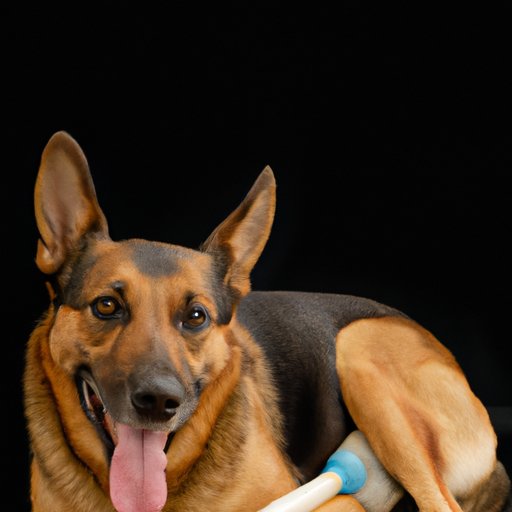
Introduction
For dog owners, noticing if their beloved pet is pregnant is not only exciting but is also crucial for both the dog’s health and the well-being of her puppies. While pregnancy can be an amazing experience for both you and your pet, it can also be a very stressful time since it’s easy to miss the signs. In this article, we’ll provide you with a comprehensive guide on how to tell if your dog is pregnant, what to expect during each stage of pregnancy, and how to take good care of your dog throughout her pregnancy.
Signs to Look for
The best way to tell if your dog is pregnant is to look for both visual and behavioral cues. Signs of pregnancy vary from dog to dog, but the most common ones include:
Physical Signs:
- Increased appetite: This may vary from dog to dog, but it’s common for many dogs to experience increased hunger during pregnancy
- Swollen belly: As the pregnancy progresses, your dog’s belly will start to become rounder and larger
- Enlarged nipples: Your dog’s nipples may begin to enlarge and darken to prepare for nursing
- Decreased appetite: This may happen in the early stages of pregnancy but should be followed-up with a veterinarian if it continues
Behavioral Changes:
- Mood swings: Your dog may experience sudden mood swings, becoming more affectionate, or easily agitated
- Nesting behavior: Your dog may start to seek out quiet and private areas to rest or prepare a den for herself and her puppies
- Excessive grooming: Your dog may start to groom herself excessively, paying more attention to her genital area in preparation for birth
Veterinary Insight
If you suspect your dog is pregnant, it’s crucial to take her to the veterinarian as soon as possible. A veterinarian can perform a physical examination and conduct tests to determine whether or not your dog is pregnant. Additionally, regular vet checkups throughout the pregnancy are critical to monitor the health of your dog and the developing pups.
One of the most important things you’ll want to discuss with your veterinarian is your pet’s nutrition. You’ll want to feed your dog a high-quality diet that’s appropriate for her age, breed and stage of pregnancy. In addition to changing your dog’s diet, you may also want to discuss making other changes to her lifestyle, like limiting exercise.
Lastly, you’ll want to have a frank discussion with your veterinarian about the risks associated with dog pregnancy. By doing so, you can prepare yourself for any possible complications, like miscarriage, that might arise.
Pregnancy Timeline
The length of a dog’s pregnancy can vary depending on the breed and size of the dog, but, in general, most dogs carry their puppies for about 9 weeks.
During the first four weeks of pregnancy, dogs may not show many physical signs of pregnancy. However, as the pregnancy progresses, your dog’s body will begin to go through several changes. This includes weight gain, breast development, and increased appetite.
During the fifth week of pregnancy, the puppies’ skeletal systems start to develop, and you may begin to feel the puppies move. At around week seven, your dog’s mammary glands will start to enlarge, and her milk will begin to produce.
In the final stage of pregnancy, most dogs will begin to show signs of labor which may occur one to two days before birth. Signs of labor include panting, restlessness, and obvious discomfort.
Home Testing
If you suspect your dog is pregnant and wish to perform an at-home test, there are several safe and accurate options available. At-home pregnancy tests can be purchased at a pet store or online, and use the same methodology as human pregnancy tests. These tests detect the hormone called relaxin that’s produced during pregnancy. Do note that these tests may not be as accurate as a veterinarian’s assessment.
Genetic Predictors
While physical and behavioral signs can be a good indicator that your dog is pregnant, breed-specific tendencies can also give you an idea of whether your dog is pregnant. For instance, the nipples of a pregnant Pomeranian may darken and become more prominent. Similarly, a pregnant Doberman’s coat may appear more lustrous. Researching your dog’s breed-specific traits can provide insight into these aspects.
Nutrition and Care
Providing proper nutrition for your pregnant dog is essential to both her health and the puppies’. You should talk with your veterinarian about altering her diet to one that’s rich in calories and high in protein during the various stages of pregnancy. Additionally, you’ll want to ensure your dog is drinking enough water and taking regular exercise, providing as much as possible.
Delivery Preparation
As your dog’s delivery date approaches, you’ll want to prepare in advance to ensure a comfortable and safe birthing experience. It’s a good idea to set up a whelping box in a quiet, private room where your dog can give birth to her puppies. You’ll also want to have towels and a heating pad on hand. If there are any indications of any complications such as labor lasting more than 24 hours, it’s important to contact your veterinarian immediately.
Conclusion
Dog pregnancy can be a rewarding experience for both you and your pet if you know how to care for your pregnant dog properly. By paying attention to the physical and behavioral changes in your dog, and getting regular veterinary check-ups, you can ensure a safe and happy pregnancy for your pet.





